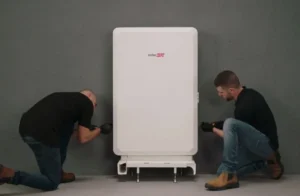The polemics around carbon pricing have been largely shunted into the background following the passage of the government’s legislation, but a far more important piece of legislation for the short and medium term future of the clean energy industry in Australia will be presented to parliament this year – the Clean Energy Finance Corporation. And it seems there could be more at stake for the energy industry than the carbon price itself.
The CEFC was included in the government’s Clean Energy Future package last year largely at the behest of the Greens. The purpose is to arm the CEFC – an independent body operating as some sort of green investment bank – with $10 billion of government funds over 5 years, and mechanisms such as loan guarantees, in the hope of extracting a multiple of that figure from private finance to deploy some of the new technologies that have not yet seen the light of day in Australia – solar thermal, geothermal, energy storage, and energy infrastructure.
It promises to be a hot debate – not just because of the politics of the issue (clean energy sources have become like the carbon and climate debates, split asunder between the left and right) – but also because of the massive implications for a range of stakeholders – the developers and backers of emerging technologies, the proponents of “mature” low carbon energy sources such as wind power, and the current incumbents in the energy sector – mostly coal and gas.
Amid the rhetoric, there are some interesting technical challenges for the group led by the highly respected Reserve Bank board member Jillian Broadbent and her team who have been asked to devise the structure and the governance of the CEFC – exactly what sort of mechanisms will work best for the deployment of such technologies in Australia, what will be the impact on the Renewable Energy Target and – if the CEFC is charged with delivering a return on its investment, then how is that defined, and how exactly does it achieve that while encouraging the development of pre-commercial technologies.
The idea behind the CEFC mechanisms and its equivalents overseas is that if the world is going to decarbonise its energy industry – as it surely must if it takes any attention to the science – then the earlier technologies are deployed then the quicker and cheaper this transformation can occur. This is the conclusion of any number of studies from the International Energy Agency, the European Union, the US Department of Energy, the Chinese government, and from economics such as Lord Stern, and explains why governments in those countries are deploying a host of various measures – from carbon pricing, emissions standards, renewable energy targets, cheap finance and loan guarantees and feed in tariffs.
It is also the experience of the technology developers themselves – reducing costs is not just a matter of tinkering around in laboratories, as some like to suggest, it is a matter of deployment, of learning by doing, as the IEA suggests. As a local case in point, First Solar, the US solar giant that is building Australia’s first utility scale installation near Geraldton, says nearly two thirds of the cost reductions needed to reach the point where it can be deployed without subsidies will come from local knowledge – in installation, infrastructure, financing and operation.
Needless to say, there is a lot at stake, and the debate in Australia is a microcosm of what is occurring elsewhere in the world. According to the IEA’s World Energy Outlook, if you assume that the world is going to de-carbonise its energy systems by 2050, it’s worth $1 trillion a year for the incumbents. That’s a significant sum and worth the spending of lobbying fees – each year of delay would seemingly deliver a more attractive rate of return than investing in technologies such as CCS, judging by the way the world’s coal miners are disbursing their money.
The dozens of submissions that have been made to Broadbent’s team from individual companies and lobby groups can broadly be summarized in three groups: those pushing for the CEFC to use various mechanisms to get these technologies deployed, and to reap the reward of Australia’s ample resources and excellent R&D; those anxious that it could distort the current market, and displace other technologies such as wind currently favoured by the RET – they want the CEFC to focus on supporting infrastructure that can benefit all technologies; and those who want the funds focused on R&D, and avoid, at any cost, anything that could encourage their immediate deployment.
Those greatly opposed to the CEFC want all “complementary measures” – including the renewable energy target -dumped now that there will be a carbon price. They often cite Garnaut as their reference point. But the basic assumptions of Garnaut’s position was that this would be appropriate only if the carbon price was high enough to do the job, or the emission reduction targets in a cap and trade scheme at least reflected the science, which they don’t. In any case, mechanisms such as the RET are self correcting – the more the carbon price rises, the lower the price of the renewable energy certificates.
The question facing the CEFC is what role it should play in deploying technologies, and which, how and why. The generators says that if it has to go anyway, it should go to R&D, again citing Garnaut without his caveats. Their professed concern is rising cost, but their real fear is the impact on their revenue. The merit order effect, where established generators such as coal and gas are displaced by low marginal cost fuels such as wind and solar, is already eating away at generator earnings. A wide deployment of solar PV, for example, may prove disastrous, providing plenty of energy at near zero marginal cost just at the peaks that deliver the icing on the generators’ cake – more than 25 per cent of the revenue from the NEM come from 36 hours of extreme peak, and lot of the other revenue comes from more moderate peaks.
But these generators are not the only ones concerned. The wind industry has been frustrated by badly framed policies that have effectively stalled some $15 billion in planned development. They are also facing growing restrictions in planning rules in several key states. They fear that favouring “nearly ready” to deploy solar PV by reducing their cost of finance – as the solar industry proposes – will find their projects missing out sooner than otherwise might be expected. They are pushing for the CEFC to focus on “enabling technologies” such as new grids to help access remote energy sources, or even storage.
There are suggestions that the displacement could be avoided if all CEFC investments could be deemed over and above the RET, but then that would require even greater investment into those projects because renewable energy certificates would not be available. Expanding the RET may be one solution, but the bottlenecks have already made that target difficult to reach, and will likely be fiercely resisted by the energy retailers.
These are technical, though important issues. Broadbent’s committee is likely to be able to find a middle path that responds to these concerns. The biggest challenge for the CEFC will be negotiating the political rhetoric, and having the legislation make its way through Parliament. You can expect to hear a lot about the failed US solar firm Solyndra.
By any measure, Australia has fallen pitifully behind the rest of the world in the development and the deployment of the clean technologies that will inevitably come to dominate the global energy industry in the future. It has made good on its promise of not picking winners, but presumably not in the way intended. The grants based systems that has characterized the efforts of the Labor government and the Coalition that preceded it have clearly failed, and it’s time that a more commercial-orientated approach is adopted. It’s going to be a critical year.






